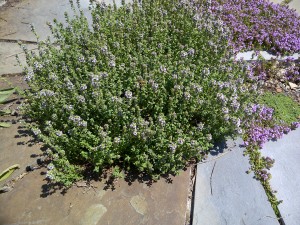 Thyme (Thymus vulgaris) is a small, woody subshrub native to the Mediterranean area where it has been in use for thousands of years. The Egyptians used it when embalming their dead. The oil, thymol, contains antibacterial properties that helped preserve the bodies.
Thyme (Thymus vulgaris) is a small, woody subshrub native to the Mediterranean area where it has been in use for thousands of years. The Egyptians used it when embalming their dead. The oil, thymol, contains antibacterial properties that helped preserve the bodies.
That association with death persisted through the Middle Ages when thyme was often placed in coffins to assure safe passage to Heaven for the dead. The Greeks burned it as incense in their temples, believing it would give them courage. This belief was still prevalent in the Middle Ages when ladies would give sprigs of thyme to their knights to give them courage in battle. The Romans used thyme to purify their interior rooms. They were the first to use it as a culinary herb, adding it to cheeses and liqueurs. It is believed that it was the Romans who spread both thyme and its use throughout Europe, including Great Britain.
The essential oil, thymol, which gives thyme its distinctive taste, has antiseptic properties. Before the discovery of antibiotics, oil of thyme was used in bandages to prevent infection. Nowadays, thymol is used as an ingredient in mouthwashes such as Listerine and in all-natural hand-sanitizers. You will also find it in natural cleaning products.
Thyme is perennial in zones 5 through 9. It prefers a sunny location, but will tolerate some shade. It must be dry, however. Too much moisture will rot the roots. Depending on the cultivar, the plants grow 6” to 12” high. Cultivars include orange thyme, which has a hint of orange flavor, lemon thyme, which has a hint of lemon flavor, and silver thyme which has a lovely silver variegation on its leaves. Thyme can be pruned into small hedges and used as edging or in a knot garden. The tiny flowers can be white, pink or lavender and appear in the spring. Bees love them. Thyme gives a distinctive flavor to honey.
Thyme is most often propagated by cuttings because seed germination is not reliable and can take anywhere from 8 to 20 days. Cuttings should be started indoors 6 weeks before your last frost date. Seeds, which take longer to germinate, should be started 10 weeks before your last frost date. The resulting plants can be moved outdoors to your garden as early as 2 to 3 weeks before your last frost although they will grow best when the soil reaches 70⁰F.
Thyme can be harvested any time during the growing season. Freshly harvested thyme will last up to 1 week or it can be frozen for up to 6 months. If you plan on drying your thyme, wait until after your plants have blossomed for the most flavor. You can dry either the whole sprigs (tied together and hung upside down in a dark, dry, well-ventilated area) or just the leaves. The tiny leaves are best dried in the oven (110⁰F for 1 to 2 hours), the microwave (1 to 2 minutes on high) or in a food dehydrator.
English or Common thyme is used most often in cooking. It is one of the ingredients in Bouquet Garni, where it is used fresh and in Fines Herbes, where it is used dried. When a recipe calls for a sprig of thyme, it is referring to a single “branch” with its leaves attached. If the recipe specifies the amount in teaspoons, it is referring to just the leaves which can be removed from the branch by sliding it through the tines of a fork or using a knife. After struggling with removing the tiny leaves from the branches, now I just “guesstimate” and throw an appropriate number of sprigs into my pan.
Thyme can also be used as a companion plant in your vegetable garden. It is most often planted next to cabbage and broccoli because it deters cabbage worms and white flies.

